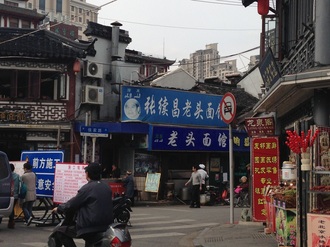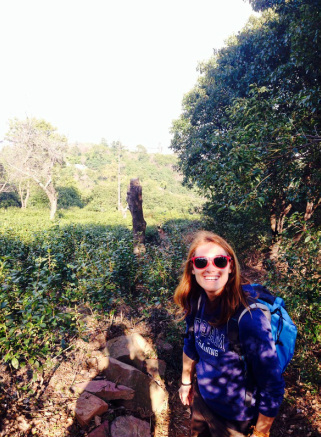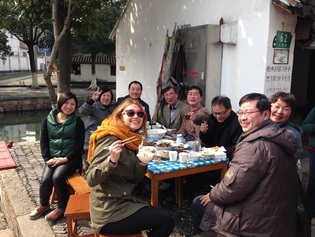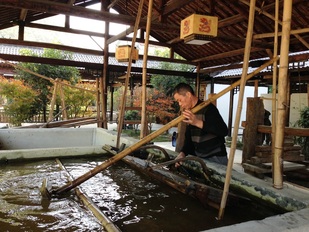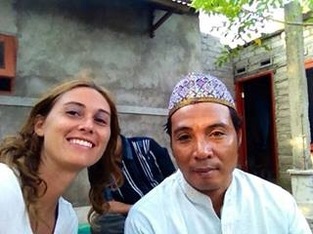|
When I first landed in China, almost one year ago, I was eager to explore a country so wide and full of diversities and possibilities.
With its peaks, deserts, huge chaotic cities, ancient monuments and even sub tropical islands, it seemed to me like the promise land of the Traveler, a world in which I could get myself lost forever. Then I settled in Shanghai, a city which is mainland China's most enthusiastic gateway to the West and a crowded version of New York, with skyscrapers growing every month and the shudder of construction work providing a constant soundtrack. At the beginning I was overwhelmed, and got entangled in this huge reality where everything is at hand’s reach and where you can literally feel like you’re in the centre of the world: it seems everyone is passing by Shanghai, and you can easily wander around from Art deco-buildings exploration to old traditional houses or water towns. Not to mention the fact you can easily board a plane and fly to the exotic likes of the Philippines and Korea and Japan in less than two hours. So I began to spin like a top, spending all my weekends between monuments and attractions, my travel-book in one hand, my map of the city in the other, always moving at a fast pace, fearing I would lose something new happening around the corner. When it seemed to me that Shanghai had no more secrets, I flew to Hong Kong, then Shenzhen and Macau, then Harbin and Beijing, and back closer to the city, with day tours to Hangzhou, Suzhou, Nanjing….then abroad again, in Bali, Kuala Lumpur, Philippines. I had no rest, I was always on the (fast) move. Until I got tired. It took me about six months to understand that I couldn’t go on with that pace. One day I was trying to remember the name of a very touristic pagoda in Suzhou and couldn’t: it was confused among tenths of others monuments I had visited in the past four weeks. And I couldn’t think of any other details about that place: how old it was, who built it, what his purpose. It was just a red spot on my map, a name I could cross in my travel-book. Done. Then I remembered about something I read back when I was in my hometown in Italy. It’s called Slow Travel. It’s a movement emerging in the footsteps of the Slow Food movement, which (what a coincidence!) began in my country with the purpose to keep fast food establishments out of historically and culturally significant districts in cities, and the aim to protect local culture and heritage, instead. The Slow Food movement started in Rome, then spread in the whole world as a cultural revolution against the notion than faster is better, that the more the better. And the concept can be applied to many different fields in life. Slow Travel, for example, is about experiences over sights; it’s about getting to know one place well, focus on quality rather than quantity, and try to establish a connection with locals. It’s also about discovery, and taking your time to observe and understand, ask questions, get lost, follow directions, be in the moment and take pleasure from simple things. It’s about pursuing personal growth by going deeper in trying to make sense of what surrounds you, to develop a knowledge of how things work and how people think. I still like to visit tourist attractions, still dream of the day when I’ll finally go to Angkor Wat, so Slow Travel for me doesn’t mean that I have to avoid going to the Great Wall or visiting the Ice Festival and the frozen Songhua River to go hiking, instead, for a super remote village in Papua New Guinea. But it means that I try to visit smaller cities and villages, besides the touristic spots, and spend a bit more time in each location instead of rushing to the next one; it’s more about taking my time to lazily stroll around my neighbor on a Sunday morning, enjoy a street market or wander around the stunning Taihu Lake or in a peaceful tea field in the Zhejiang countryside. It’s about taking the time to process whatever I’m doing or seeing, rather than rush for the next destination. By beginning to follow some suggestions of the Slow Travel movement I discovered sections of the Hongkou district of Shanghai that look like time had passed by, and part of the French Concession which weren’t reached by China’s modernization: still full of ancient teashops and neighborhood barbershops and alley restaurants that make Shanghai look metropolitan and super modern and, at the same time, neighborly and familiar. And since Slow Travel is also about the art of doing nothing (which is something I’m really good at!), I quit rushing for events and attractions and started lounging in parks, people-watching in cafes, wandering down side alleys and enjoying the locals’ performances. In People Square’s Park I watched tai-chi classes and sat among the mahjong and cards players; on the Chao Praya river I lied down for hours, my eyes closed, my hand touching the water, enjoying the humid, stinky heat and the swinging of the slowest ferry on earth. I remember with great pleasure a Sunday lunch in Jinze with my colleague Valerio: we went to that tiny water-town even most shanghainese haven’t heard of and stumbled upon an old classmates’ reunion: some locals who were having a lunch in a corner of a street invited us to share their table, and we spent a few hours getting to know each-other, enjoying a lazy, sunny afternoon of chit chats. But in the long run, activities are much more interesting that sight-seeing, and can give you a better insight into the culture. So, I’ve moped around Shanghai, Palawan and Java, joining hundreds of people on their scooter in the crowded roads of Hongqiao, El Nido and Yogyakarta, and that made me really feel part of the community. I’ve scuba-dived, rode horses, hiked, learnt to cook tang yuan, kayaked, and many more activities around the Chinese country-side and the South East of Asia. I’ve found that Slow traveling has given a new meaning to my trips and an excuse to stay longer in places which maybe lack tourist attractions but have much more to offer in terms of experiences and relationships with the locals. Getting out of my comfort zone has also made me growth in confidence and gave me the strength to challenge my fears and insecurities. It’s also often a cheaper way of seeing the world and a sustainable way of travel since I’ve the chance to directly support local businesses and communities. And, in the end, it’s more likely to happen that I’ll remember these experiences and communities rather than those where I visited the same tourist attractions as everyone else, without any chance to interact with the locals. |
Wandering around my neighbor on a lazy Sunday morning
Hiking in Dongshan, Jiansu province.
Enjoying a country-side lunch with locals in the outskirts of Shanghai.
Learning to make rice paper in the Zhejiang country-side.
With my host, Mr Kedek, in Indonesia.
|
|
|

